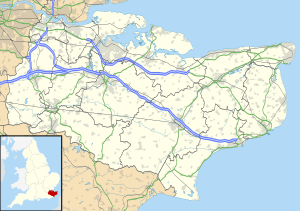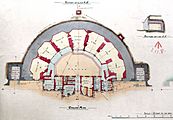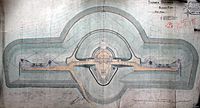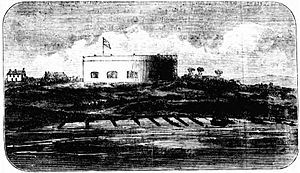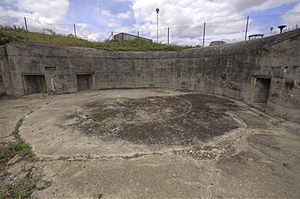Slough Fort facts for kids
Quick facts for kids Slough Fort |
|
|---|---|
| Allhallows-on-Sea, Kent, England | |
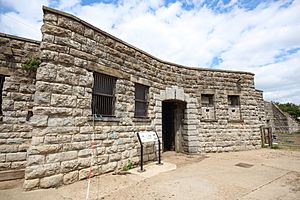
Main entrance to Slough Fort
|
|
| Coordinates | 51°28′33″N 0°38′41″E / 51.475737°N 0.644842°E |
| Type | Fortification |
| Site information | |
| Owner | Private owners |
| Condition | Mostly intact |
| Site history | |
| Built | 1867 |
| Built by | United Kingdom |
| In use | 1867–1929 |
| Materials | Concrete, granite, brick, Kentish ragstone |
Slough Fort is a small fort built to hold powerful guns. It stands at Allhallows-on-Sea in Kent, England. The fort was built in 1867. It was shaped like a letter 'D' and was meant to protect a part of the River Thames. This area was seen as a possible landing spot for enemies.
The fort was built during a time when Britain and France were rivals. It had seven special rooms called casemates for guns. These guns were later replaced with even stronger ones. These new guns could hide below ground after firing. Slough Fort was likely one of the smallest forts built to protect Britain from invasion.
The guns were removed by 1912. However, the fort was still used during the First World War. It served as a command post, helping to direct operations. The fort was officially closed in 1920 and sold in 1929. Since the 1960s, it has been used as stables next to a holiday camp. The camp's owners helped fix up parts of the fort in 2012–13. This work uncovered hidden parts of the old structure.
Why Was Slough Fort Built?
Britain's old coastal defenses were not strong enough. This was because new, powerful guns were invented. These guns were used on fast, armored warships. The River Thames was very important to Britain. It was a major trade route. It also had important naval sites like Woolwich Arsenal.
To deal with this threat, the government formed a group. This group was called the Royal Commission on the Defence of the United Kingdom. In 1860, they suggested building many new forts. They also recommended upgrading old ones. About 70 forts and batteries were built around England's coast. Slough Fort was one of these new forts.
Building the Fort
Slough Fort got its name from nearby farms that are now gone. Its location was chosen carefully. It sat on a ridge overlooking the river. This spot was the only place for miles where an enemy could land. The rest of the shoreline was marshy. A fort here could stop any enemy landing attempts.
It also filled a gap between other forts. These included Cliffe and Grain. An 1869 report said the fort was built "to prevent an enemy landing." This would stop them from attacking Chatham Dockyard from the north.
The land for the fort was bought in 1861. The War Office paid £1,639 for it. The fort itself was built in 1867. It was shaped like a half-circle. It had seven gun rooms (casemates) facing the river. There was a defensive ditch in front of them.
Each casemate was made of granite. Ammunition was stored below and brought up by hoists. A strong blockhouse made of Kentish ragstone closed off the back of the fort. This blockhouse also held the living quarters for the soldiers. The main entrance was in the middle of this blockhouse. A small paved area was in the center of the fort.
After it was built, the ground behind the fort was raised. This created a gentle slope called a glacis. On the roof of the fort, there was a lookout spot. Soldiers could get to it by two spiral staircases. This spot was protected by a low wall called a banquette. This allowed soldiers to fire rifles easily.
How the Fort Was Used
Slough Fort first had seven 7-inch guns in its casemates. It was manned by three officers and 76 other soldiers. Between 1889 and 1891, two new concrete gun areas were built. These were on either side of the main fort. A range finder was added to the fort's roof.
These new areas held two 9.2-inch and two 6-inch guns. These guns were on special mounts that made them disappear after firing. This meant they could hide below ground. These new guns were much more powerful. They could hit a battleship from far away. The old 7-inch guns were then removed.
The fort's structure changed a lot around this time. The casemates were covered with earth. This made them harder to hit. The inside of the casemates was partly filled with rubble. The ditch in front was also filled in. This helped to hide the fort.
Two smaller, fast-firing guns were put on the roof. These were to protect against small, quick boats. The rest of the fort became barracks for soldiers. Three casemates became homes for married soldiers. One was for officers, and three were for other soldiers. More living quarters were built nearby for other staff.
In 1906, two new 9.2-inch guns were added. These guns could recoil (move back) along their axis. This allowed them to fire much faster. The remaining guns were removed by 1907. During the First World War, the fort was a command post. It worked with a signal station nearby. This station watched all ships entering the Thames. The last two 9.2-inch guns were moved in 1917.
The Army stopped using the fort in 1920. In 1929, it was sold and became a small zoo. It was used by the military again just before and during the Second World War. It was an observation post from 1938. It became part of the local defense system in 1939–40. It was also used to help defend against V-1 flying bombs in 1944.
After the war, the fort changed owners a few times. There were plans to tear it down. But it was too expensive. Instead, it became a riding stables in the early 1960s.
Slough Fort Today
Slough Fort is still mostly intact today. Some parts have been damaged. For example, one gun position is missing. The fort is surrounded by caravans from the Allhallows Leisure Park. In 2009, English Heritage made it a Grade II* listed building. This means it is a very important historic site. It shows how weapons and coastal defenses changed over time.
The wing batteries (the areas where the newer guns were) are also protected. They are a scheduled monument. This is because they are rare and well-preserved.
The fort is privately owned and still used as stables. The old casemates are now horse stalls. The main part of the fort is not open to the public. However, the owners of the nearby holiday park have helped restore parts of it. They cleared tons of debris from the wing batteries. They also created a walking path between them. Signs have been put up to show visitors what the fort looked like. The Slough Fort Preservation Trust is working to repair the fort. They also hope to make it more accessible to the public.


